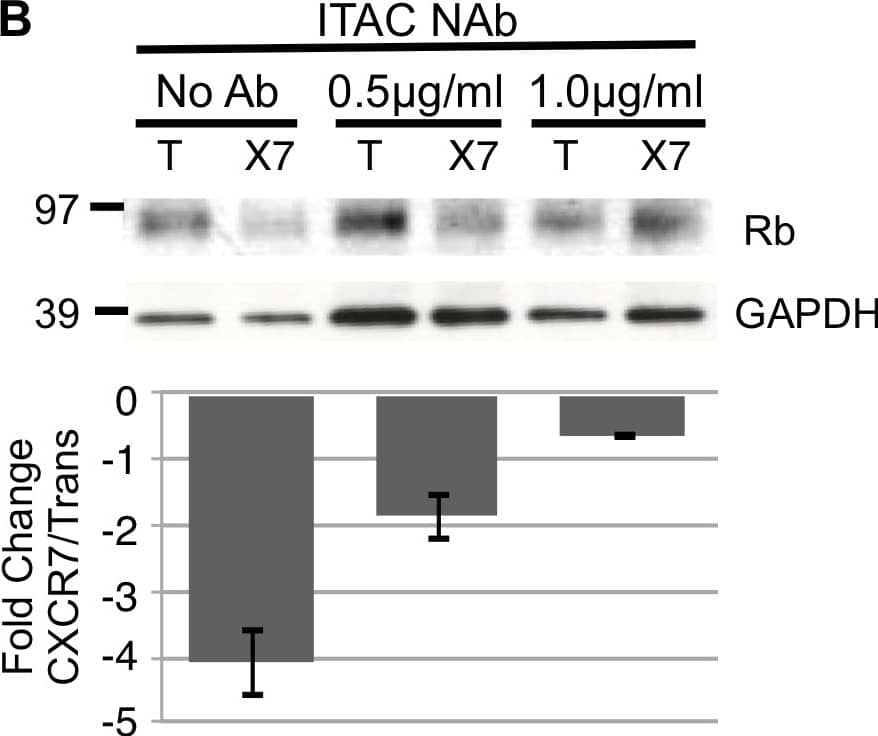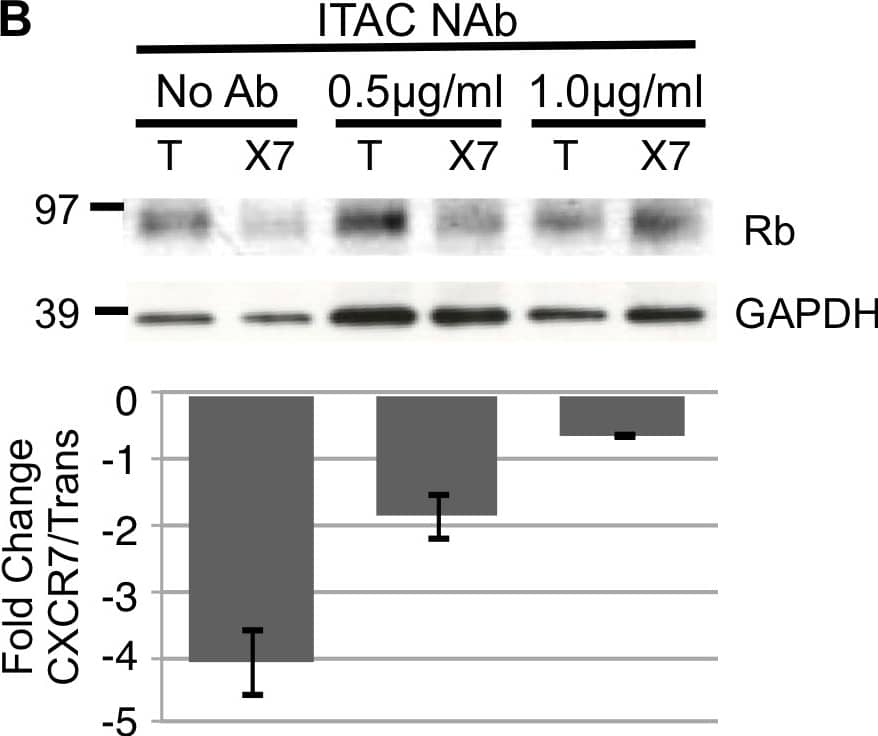Human CXCL11/I-TAC Antibody Summary
I-TAC is observed.
Phe22-Phe94
Accession # O14625
Applications
Please Note: Optimal dilutions should be determined by each laboratory for each application. General Protocols are available in the Technical Information section on our website.
Scientific Data
 View Larger
View Larger
Chemotaxis Induced by CXCL11/I‑TAC and Neutralization by Human CXCL11/I‑TAC Antibody. Recombinant Human CXCL11/I-TAC (Catalog # 672-IT) chemoattracts the BaF3 mouse pro-B cell line transfected with human CXCR3 in a dose-dependent manner (orange line). The amount of cells that migrated through to the lower chemotaxis chamber was measured by Resazurin (Catalog # AR002). Chemotaxis elicited by Recombinant Human CXCL11/I-TAC (0.05 µg/mL) is neutralized (green line) by increasing concentrations of Goat Anti-Human CXCL11/I-TAC Antigen Affinity-purified Polyclonal Antibody (Catalog # AF260). The ND50 is typically 0.5-1.5 µg/mL.
 View Larger
View Larger
Detection of Human CXCL11/I-TAC by Block/Neutralize CXCR7-mediated Rb degradation requires ligand.pLEC cultures were infected with Trans only or Trans+CXCR7. At 6 hours post-infection, media was replaced with media only or media containing (A) SDF-1/CXCL12 neutralizing antibody at 1.5, or 3.0 µg/ml or (B) ITAC/CXCL11 neutralizing antibody at 0.5 or 1.0 µg/ml. At 20 hours post infection, cells were lysed and analyzed by western blot for total Rb levels. Densitometry analysis was performed and fold change values were calculated from GAPDH-normalized optical density ratios as described for Figure 3. Bar graphs (bottom) represent the average fold change at each condition for two independent experiments. Image collected and cropped by CiteAb from the following open publication (https://dx.plos.org/10.1371/journal.pone.0069828), licensed under a CC-BY license. Not internally tested by R&D Systems.
 View Larger
View Larger
Detection of Human CXCL11/I-TAC by Block/Neutralize CXCR7-mediated Rb degradation requires ligand.pLEC cultures were infected with Trans only or Trans+CXCR7. At 6 hours post-infection, media was replaced with media only or media containing (A) SDF-1/CXCL12 neutralizing antibody at 1.5, or 3.0 µg/ml or (B) ITAC/CXCL11 neutralizing antibody at 0.5 or 1.0 µg/ml. At 20 hours post infection, cells were lysed and analyzed by western blot for total Rb levels. Densitometry analysis was performed and fold change values were calculated from GAPDH-normalized optical density ratios as described for Figure 3. Bar graphs (bottom) represent the average fold change at each condition for two independent experiments. Image collected and cropped by CiteAb from the following open publication (https://dx.plos.org/10.1371/journal.pone.0069828), licensed under a CC-BY license. Not internally tested by R&D Systems.
Preparation and Storage
- 12 months from date of receipt, -20 to -70 °C as supplied.
- 1 month, 2 to 8 °C under sterile conditions after reconstitution.
- 6 months, -20 to -70 °C under sterile conditions after reconstitution.
Background: CXCL11/I-TAC
CXCL11, also known as I-TAC, SCYB9B, H174 and beta -R1, is a non-ELR CXC chemokine. CXCL11 cDNA encodes a 94 amino acid (aa) residue precursor protein with a 21 aa residue putative signal sequence, which is cleaved to form the mature 73 aa residue protein. CXCL11 shares 36% and 37% amino acid sequence homology with IP-10 and MIG (two other known human non-ELR CXC chemokines), respectively. CXCL11 is expressed at low levels in normal tissues including thymus, spleen and pancreas. The expression of CXCL11 mRNA is radically up regulated in IFN-gamma and IL-1 stimulated astrocytes. Moderate increase in expression is also observed in stimulated monocytes. CXCL11 has potent chemoattractant activity for IL-2 activated T cells and transfected cell lines expressing CXCR3, but not freshly isolated T cells, neutrophils, or monocytes. The gene encoding CXCL11 has been mapped to chromosome 4.
- Cole, K. et al. (1998) J. Exp. Med. 187:2009.
- Sandhya Rani, M. et al. (1996) J. Biol. Chem. 271:22878.
- Lou, Y. et al. (1998) J. Neurovirol. 4:575.
Product Datasheets
Citations for Human CXCL11/I-TAC Antibody
R&D Systems personnel manually curate a database that contains references using R&D Systems products. The data collected includes not only links to publications in PubMed, but also provides information about sample types, species, and experimental conditions.
3
Citations: Showing 1 - 3
Filter your results:
Filter by:
-
Aberrant Proliferation in CXCR7+ Endothelial Cells via Degradation of the Retinoblastoma Protein
Authors: Jennifer E. Totonchy, Jessica M. Osborn, Sara Botto, Lisa Clepper, Ashlee V. Moses
PLoS ONE
-
Layer-specific expression of extracellular matrix molecules in the mouse somatosensory and piriform cortices
Authors: H Ueno, S Suemitsu, S Murakami, N Kitamura, K Wani, Y Matsumoto, M Okamoto, T Ishihara
IBRO Rep, 2018-11-28;6(0):1-17.
Species: Mouse
Sample Types: Whole Tissue
Applications: IHC-Fr -
Villitis of unknown etiology is associated with a distinct pattern of chemokine up-regulation in the feto-maternal and placental compartments: implications for conjoint maternal allograft rejection and maternal anti-fetal graft-versus-host disease.
Authors: Kim MJ, Romero R, Kim CJ, Tarca AL, Chhauy S, LaJeunesse C, Lee DC, Draghici S, Gotsch F, Kusanovic JP, Hassan SS, Kim JS
J. Immunol., 2009-03-15;182(6):3919-27.
Species: Human
Sample Types: Whole Tissue
Applications: IHC-Fr
FAQs
No product specific FAQs exist for this product, however you may
View all Antibody FAQsReviews for Human CXCL11/I-TAC Antibody
There are currently no reviews for this product. Be the first to review Human CXCL11/I-TAC Antibody and earn rewards!
Have you used Human CXCL11/I-TAC Antibody?
Submit a review and receive an Amazon gift card.
$25/€18/£15/$25CAN/¥75 Yuan/¥2500 Yen for a review with an image
$10/€7/£6/$10 CAD/¥70 Yuan/¥1110 Yen for a review without an image

